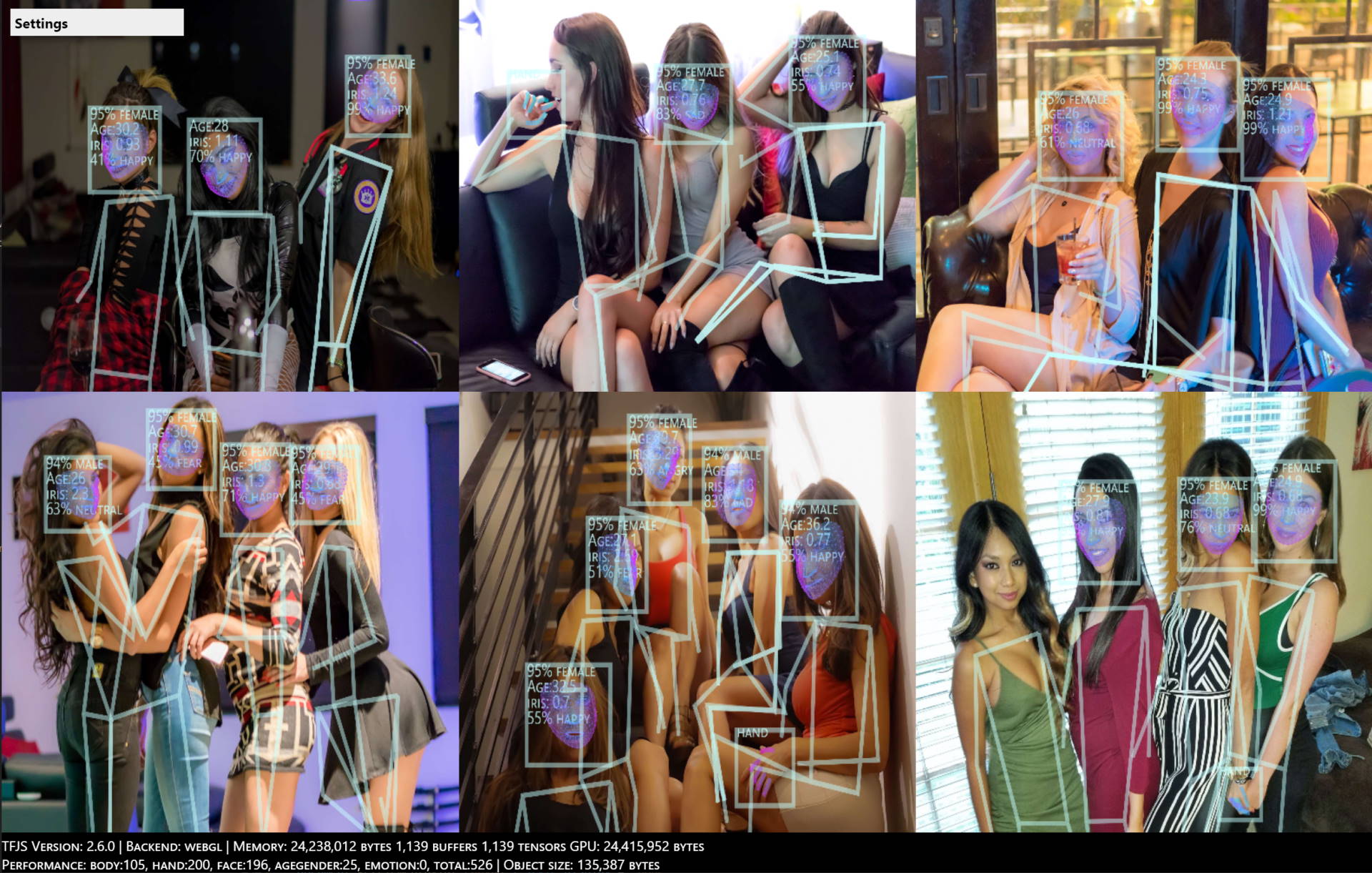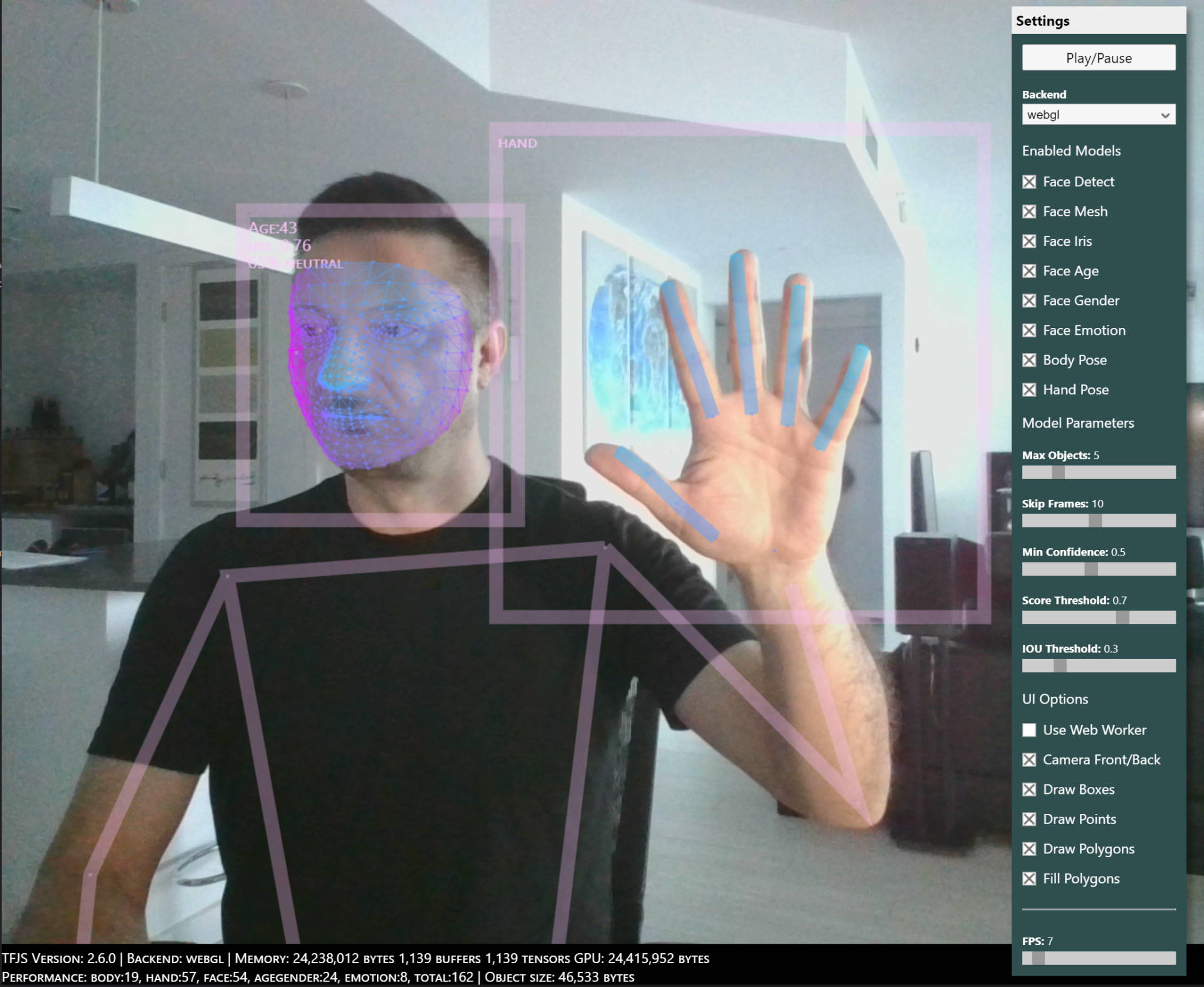|
|
||
|---|---|---|
| assets | ||
| demo | ||
| dist | ||
| models | ||
| src | ||
| .eslintrc.json | ||
| .gitignore | ||
| CHANGELOG.md | ||
| LICENSE | ||
| README.md | ||
| changelog.js | ||
| config.js | ||
| favicon.ico | ||
| package-lock.json | ||
| package.json | ||
README.md
Human Library
3D Face Detection, Body Pose, Hand & Finger Tracking, Iris Tracking, Age & Gender Prediction & Emotion Prediction
Compatible with Browser, WebWorker and NodeJS execution!
(and maybe with React-Native as it doesn't use any DOM objects)
This is a pre-release project, see issues for list of known limitations
Suggestions are welcome!
Examples
Installation
Important
The packaged (IIFE and ESM) version of Human includes TensorFlow/JS (TFJS) 2.6.0 library which can be accessed via human.tf
You should NOT manually load another instance of tfjs, but if you do, be aware of possible version conflicts
There are multiple ways to use Human library, pick one that suits you:
Included
dist/human.js: IIFE format minified bundle with TFJS for Browsersdist/human.esm.js: ESM format minified bundle with TFJS for Browsersdist/human.esm-nobundle.js: ESM format non-minified bundle without TFJS for Browsersdist/human.cjs: CommonJS format non-minified bundle without TFJS for NodeJS
All versions include sourcemap
Defaults:
{
"main": "dist/human.cjs",
"module": "dist/human.esm.js",
"browser": "dist/human.esm.js",
}
1. IIFE script
Simplest way for usage within Browser
Simply download dist/human.js, include it in your HTML file & it's ready to use.
<script src="dist/human.js"><script>
IIFE script auto-registers global namespace human within global Window object
This way you can also use Human library within embbedded <script> tag within your html page for all-in-one approach
2. ESM module
Recommended for usage within Browser
2.1 With Bundler
If you're using bundler (such as rollup, webpack, esbuild) to package your client application, you can import ESM version of Human library which supports full tree shaking
Install with:
npm install @vladmandic/human
import human from '@vladmandic/human'; // points to @vladmandic/human/dist/human.esm.js
Or if you prefer to package your version of tfjs, you can use nobundle version
Install with:
npm install @vladmandic/human @tensorflow/tfjs-node
import tf from '@tensorflow/tfjs'
import human from '@vladmandic/human/dist/human.esm-nobundle.js'; // same functionality as default import, but without tfjs bundled
2.2 Using Script Module
You could use same syntax within your main JS file if it's imported with <script type="module">
<script src="./index.js" type="module">
and then in your index.js
import * as tf from `https://cdnjs.cloudflare.com/ajax/libs/tensorflow/2.6.0/tf.es2017.min.js`; // load tfjs directly from CDN link
import human from 'dist/human.esm.js'; // for direct import must use path to module, not package name
3. NPM module
Recommended for NodeJS projects that will execute in the backend
Entry point is bundle in CJS format dist/human.node.js
You also need to install and include tfjs-node or tfjs-node-gpu in your project so it can register an optimized backend
Install with:
npm install @vladmandic/human @tensorflow/tfjs-node
And then use with:
const tf = require('@tensorflow/tfjs-node'); // can also use '@tensorflow/tfjs-node-gpu' if you have environment with CUDA extensions
const human = require('@vladmandic/human'); // points to @vladmandic/human/dist/human.cjs
Since NodeJS projects load weights from local filesystem instead of using http calls, you must modify default configuration to include correct paths with file:// prefix
For example:
const config = {
body: { enabled: true, modelPath: 'file://models/posenet/model.json' },
}
Note that when using Human in NodeJS, you must load and parse the image before you pass it for detection
For example:
const buffer = fs.readFileSync(input);
const image = tf.node.decodeImage(buffer);
const result = human.detect(image, config);
image.dispose();
Weights
Pretrained model weights are includes in ./models
Default configuration uses relative paths to you entry script pointing to ../models
If your application resides in a different folder, modify modelPath property in configuration of each module
Demo
Demos are included in /demo:
Browser:
index.html,browser.js,worker.js: Full demo using Browser with ESM module, includes selectable backends and webworkers
NodeJS:
node.js: Demo using NodeJS with CJS module
This is a very simple demo as althoughtHumanlibrary is compatible with NodeJS execution
and is able to load images and models from local filesystem,
Usage
Human library does not require special initialization.
All configuration is done in a single JSON object and all model weights will be dynamically loaded upon their first usage(and only then, Human will not load weights that it doesn't need according to configuration).
There is only ONE method you need:
import * as tf from '@tensorflow/tfjs';
import human from '@vladmandic/human';
// 'image': can be of any type of an image object: HTMLImage, HTMLVideo, HTMLMedia, Canvas, Tensor4D
// 'options': optional parameter used to override any options present in default configuration
const result = await human.detect(image, options?)
or if you want to use promises
human.detect(image, options?).then((result) => {
// your code
})
Additionally, Human library exposes several classes:
human.config // access to configuration object, normally set as parameter to detect()
human.defaults // read-only view of default configuration object
human.models // dynamically maintained list of object of any loaded models
human.tf // instance of tfjs used by human
Configuration
Below is output of human.defaults object
Any property can be overriden by passing user object during human.detect()
Note that user object and default configuration are merged using deep-merge, so you do not need to redefine entire configuration
Configurtion object is large, but typically you only need to modify few values:
enabled: Choose which models to useskipFrames: Must be set to 0 for static imagesmodelPath: Update as needed to reflect your application's relative path
export default {
backend: 'webgl', // select tfjs backend to use
console: true, // enable debugging output to console
face: {
enabled: true, // controls if specified modul is enabled
// face.enabled is required for all face models: detector, mesh, iris, age, gender, emotion
// note: module is not loaded until it is required
detector: {
modelPath: '../models/blazeface/back/model.json', // can be 'tfhub', 'front' or 'back'.
// 'front' is optimized for large faces such as front-facing camera and 'back' is optimized for distanct faces.
inputSize: 256, // fixed value: 128 for front and 'tfhub' and 'front' and 256 for 'back'
maxFaces: 10, // maximum number of faces detected in the input, should be set to the minimum number for performance
skipFrames: 10, // how many frames to go without re-running the face bounding box detector
// if model is running st 25 FPS, we can re-use existing bounding box for updated face mesh analysis
// as face probably hasn't moved much in short time (10 * 1/25 = 0.25 sec)
minConfidence: 0.5, // threshold for discarding a prediction
iouThreshold: 0.3, // threshold for deciding whether boxes overlap too much in non-maximum suppression
scoreThreshold: 0.7, // threshold for deciding when to remove boxes based on score in non-maximum suppression
},
mesh: {
enabled: true,
modelPath: '../models/facemesh/model.json',
inputSize: 192, // fixed value
},
iris: {
enabled: true,
modelPath: '../models/iris/model.json',
enlargeFactor: 2.3, // empiric tuning
inputSize: 64, // fixed value
},
age: {
enabled: true,
modelPath: '../models/ssrnet-age/imdb/model.json', // can be 'imdb' or 'wiki'
// which determines training set for model
inputSize: 64, // fixed value
skipFrames: 10, // how many frames to go without re-running the detector
},
gender: {
enabled: true,
minConfidence: 0.8, // threshold for discarding a prediction
modelPath: '../models/ssrnet-gender/imdb/model.json',
},
emotion: {
enabled: true,
inputSize: 64, // fixed value
minConfidence: 0.5, // threshold for discarding a prediction
skipFrames: 10, // how many frames to go without re-running the detector
useGrayscale: true, // convert image to grayscale before prediction or use highest channel
modelPath: '../models/emotion/model.json',
},
},
body: {
enabled: true,
modelPath: '../models/posenet/model.json',
inputResolution: 257, // fixed value
outputStride: 16, // fixed value
maxDetections: 10, // maximum number of people detected in the input, should be set to the minimum number for performance
scoreThreshold: 0.7, // threshold for deciding when to remove boxes based on score in non-maximum suppression
nmsRadius: 20, // radius for deciding points are too close in non-maximum suppression
},
hand: {
enabled: true,
inputSize: 256, // fixed value
skipFrames: 10, // how many frames to go without re-running the hand bounding box detector
// if model is running st 25 FPS, we can re-use existing bounding box for updated hand skeleton analysis
// as face probably hasn't moved much in short time (10 * 1/25 = 0.25 sec)
minConfidence: 0.5, // threshold for discarding a prediction
iouThreshold: 0.3, // threshold for deciding whether boxes overlap too much in non-maximum suppression
scoreThreshold: 0.7, // threshold for deciding when to remove boxes based on score in non-maximum suppression
enlargeFactor: 1.65, // empiric tuning as skeleton prediction prefers hand box with some whitespace
maxHands: 10, // maximum number of hands detected in the input, should be set to the minimum number for performance
detector: {
anchors: '../models/handdetect/anchors.json',
modelPath: '../models/handdetect/model.json',
},
skeleton: {
modelPath: '../models/handskeleton/model.json',
},
},
};
Outputs
Result of humand.detect() is a single object that includes data for all enabled modules and all detected objects:
result = {
version: // <string> version string of the human library
face: // <array of detected objects>
[
{
confidence, // <number>
box, // <array [x, y, width, height]>
mesh, // <array of 3D points [x, y, z]> 468 base points & 10 iris points
annotations, // <list of object { landmark: array of points }> 32 base annotated landmarks & 2 iris annotations
iris, // <number> relative distance of iris to camera, multiple by focal lenght to get actual distance
age, // <number> estimated age
gender, // <string> 'male', 'female'
}
],
body: // <array of detected objects>
[
{
score, // <number>,
keypoints, // <array of 2D landmarks [ score, landmark, position [x, y] ]> 17 annotated landmarks
}
],
hand: // <array of detected objects>
[
{
confidence, // <number>,
box, // <array [x, y, width, height]>,
landmarks, // <array of 3D points [x, y,z]> 21 points
annotations, // <array of 3D landmarks [ landmark: <array of points> ]> 5 annotated landmakrs
}
],
emotion: // <array of emotions>
[
{
score, // <number> probabily of emotion
emotion, // <string> 'angry', 'discust', 'fear', 'happy', 'sad', 'surpise', 'neutral'
}
],
performance = { // performance data of last execution for each module measuredin miliseconds
body,
hand,
face,
agegender,
emotion,
total,
}
}
Build
If you want to modify the library and perform a full rebuild:
clone repository, install dependencies, check for errors and run full rebuild from which creates bundles from /src into /dist:
git clone https://github.com/vladmandic/human
cd human
npm install # installs all project dependencies
npm run lint
npm run build
Project is written in pure JavaScript ECMAScript version 2020
Only project depdendency is @tensorflow/tfjs Development dependencies are eslint used for code linting and esbuild used for IIFE and ESM script bundling
Performance
Performance will vary depending on your hardware, but also on number of resolution of input video/image, enabled modules as well as their parameters
For example, on a desktop with a low-end nVidia GTX1050 it can perform multiple face detections at 60+ FPS, but drops to 10 FPS on a medium complex images if all modules are enabled
Performance per module:
- Enabled all: 10 FPS
- Face Detect: 80 FPS (standalone)
- Face Geometry: 30 FPS (includes face detect)
- Face Iris: 25 FPS (includes face detect and face geometry)
- Age: 60 FPS (includes face detect)
- Gender: 60 FPS (includes face detect)
- Emotion: 60 FPS (includes face detect)
- Hand: 40 FPS (standalone)
- Body: 50 FPS (standalone)
Library can also be used on mobile devices
Credits
- Face Detection: MediaPipe BlazeFace
- Facial Spacial Geometry: MediaPipe FaceMesh
- Eye Iris Details: MediaPipe Iris
- Hand Detection & Skeleton: MediaPipe HandPose
- Body Pose Detection: PoseNet
- Age & Gender Prediction: SSR-Net
- Emotion Prediction: Oarriaga

